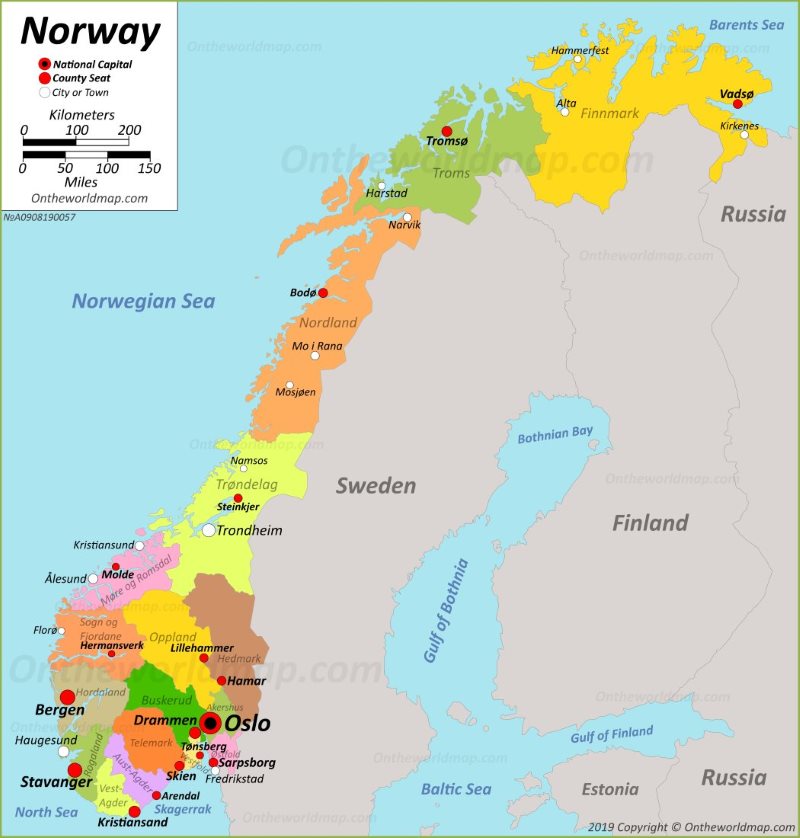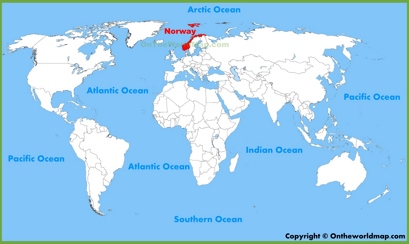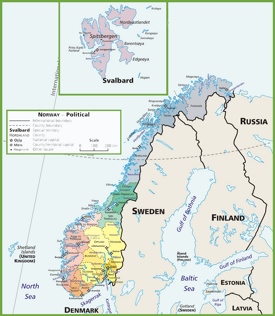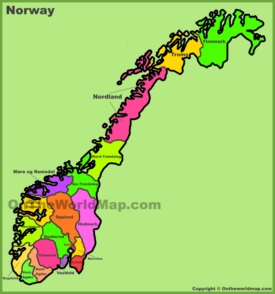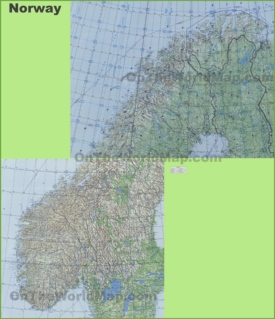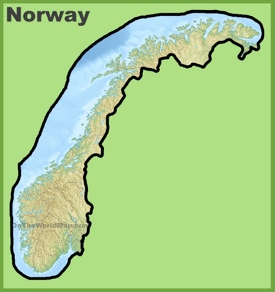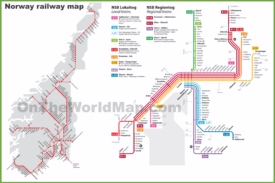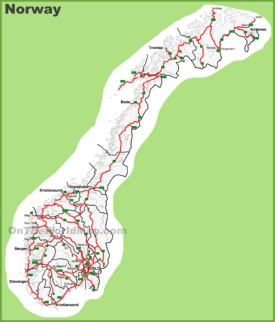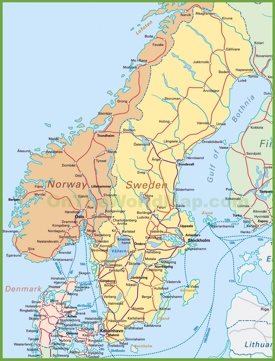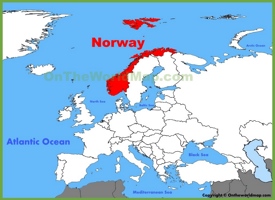Norway Map
Description:
This map shows governmental boundaries of countries; counties, county seats, and major cities and towns in Norway.
You may download, print or use the above map for educational, personal and non-commercial purposes. Attribution is required. For any website, blog, scientific research or e-book, you must place a hyperlink (to this page) with an attribution next to the image used.
Online Map of Norway
About Norway
Norway, officially the Kingdom of Norway, occupies the western portion of the Scandinavian Peninsula in Northern Europe. The country covers an area of 148,729 square miles (385,207 square kilometers), making it one of Europe's largest countries by area. Norway shares land borders with Sweden to the east, Finland to the northeast, and Russia to the far northeast. The extensive coastline stretches along the North Atlantic Ocean and the Barents Sea, featuring numerous fjords and more than 50,000 islands.
Oslo, the capital and largest city, serves as the country's political, economic, and cultural center. Other major cities include Bergen, Trondheim, Stavanger, and Tromsø. The population reached 5.55 million in 2024, with about 83% of Norwegians living in urban areas. Norwegian serves as the official language, while English proficiency ranks among the highest in non-native English-speaking countries.

The Norwegian economy combines free market activity with state ownership in key sectors. The country maintains one of the highest GDP per capita globally, supported by abundant natural resources, including oil, natural gas, hydropower, forests, minerals, and seafood. The Government Pension Fund Global, the world's largest sovereign wealth fund, manages the country's petroleum revenues and holds assets worth over $1.4 trillion. Norway consistently ranks among the top countries in terms of quality of life, income equality, and social mobility.
The country's geography features dramatic landscapes characterized by deep fjords, mountains, glaciers, and approximately 450,000 lakes. The highest peak, Galdhøpiggen, reaches 8,100 feet (2,469 meters). The unique geographical position results in significant variations in daylight hours, with parts of northern Norway experiencing the midnight sun in summer and polar nights in winter.

Tourism plays a vital role in Norway's economy, attracting visitors with its natural wonders and outdoor activities. Major attractions include the fjords, with Geirangerfjord and Nærøyfjord designated as UNESCO World Heritage sites. The Norwegian Scenic Routes project encompasses 18 designated tourist routes showcasing remarkable architecture and viewpoints. Other significant destinations include the Art Nouveau city of Ålesund, the historic Bryggen wharf in Bergen, and the Vigeland Sculpture Park in Oslo.
Norway maintains extensive infrastructure networks, including more than 50 airports with scheduled flights, an efficient railway system, and numerous tunnels and bridges connecting remote areas. The country leads in electric vehicle adoption, with electric cars accounting for over 80% of new car sales in 2022. The education system provides free education from primary school through university level, contributing to a highly skilled workforce. Norway demonstrates strong commitment to environmental protection and sustainability, with nearly all electricity production coming from renewable sources, primarily hydropower. The country aims to achieve carbon neutrality by 2030 and has implemented comprehensive policies to protect its diverse ecosystems and wildlife.
The Facts:| Flag: |

|
| Capital: | Oslo |
| Area: | 148,729 sq mi (385,207 sq km) |
| Population: | ~ 5,550,203 (2024 estimate) |
| Official language: | Norwegian, Sámi |
| Religion: |
|
| Currency: | Norwegian krone (NOK) |
| Driving side: | Right |
| Calling code: | +47 |
| Internet TLD: | .no |
| Time zone: | UTC+1 (CET) Summer (DST) UTC+2 (CEST) |
| Gross domestic product (PPP) (2024 estimate): |
|
| Gross domestic product (nominal) (2024 estimate): |
|
| Official government website: | www.regjeringen.no |
Google Map of Norway
List of Largest Cities in Norway
- Moss (46,618)
- Haugesund (44,830)
- Sandefjord (43,595)
- Arendal (43,084)
- Bodø (40,705)
- Tromsø (38,980)
- Hamar (27,324)
- Halden (25,300)
- Larvik (24,208)
- Askøy (23,194)
The Best Coastal Towns in Norway
Counties of Norway
| Region | Capital | Area | Population |
|---|---|---|---|
| Oslo | City of Oslo | 175 sq mi (454 sq km) | 700,000 |
| Rogaland | Stavanger | 3,620 sq mi (9,377 sq km) | 475,000 |
| Møre og Romsdal | Molde | 5,543 sq mi (14,356 sq km) | 270,000 |
| Nordland | Bodø | 14,732 sq mi (38,155 sq km) | 239,000 |
| Østfold | Sarpsborg | 1,614 sq mi (4,181 sq km) | 299,647 |
| Akershus | Oslo | 1,899 sq mi (4,918 sq km) | 630,752 |
| Buskerud | Drammen | 5,756 sq mi (14,908 sq km) | 284,955 |
| Innlandet | Hamar | 20,105 sq mi (52,072 sq km) | 375,000 |
| Vestfold | Tønsberg | 837 sq mi (2,168 sq km) | 253,555 |
| Telemark | Skien | 5,907 sq mi (15,298 sq km) | 175,546 |
| Agder | Kristiansand | 6,345 sq mi (16,434 sq km) | 299,000 |
| Vestland | Bergen | 13,078 sq mi (33,871 sq km) | 632,000 |
| Trøndelag | Steinkjer | 16,294 sq mi (42,202 sq km) | 465,000 |
| Troms | Tromsø | 10,112 sq mi (26,189 sq km) | 168,340 |
| Finnmark | Vadsø | 18,779 sq mi (48,637 sq km) | 75,540 |
Geography of Norway
Norway occupies the western portion of the Scandinavian Peninsula in Northern Europe, norwegian coastline extends 25,148 kilometers, including fjords and islands. Over 50,000 islands dot the coastline, with the Lofoten and Vesterålen archipelagos representing the most prominent island groups. The country's terrain consists predominantly of high plateaus and rugged mountains, with Galdhøpiggen in the Jotunheimen range standing as the highest peak at 2,469 meters above sea level.
The climate in Norway varies significantly due to its extensive latitudinal range and the influence of the North Atlantic Current. The coastal regions experience a maritime climate with mild winters and cool summers, while inland areas feature a more continental climate with colder winters and warmer summers. The northern regions, particularly above the Arctic Circle, undergo periods of midnight sun in summer and polar nights in winter. Annual precipitation ranges from 500mm in eastern valleys to over 3,000mm in certain western coastal areas.
Glaciers cover approximately 1% of mainland Norway, with Jostedalsbreen representing the largest ice sheet in continental Europe. The country's numerous fjords, formed by glacial erosion during ice ages, characterize its western coast. Notable fjords include Sognefjorden, the longest and deepest in Europe, extending 204 kilometers inland.
Norway's diverse geography supports distinct vegetation zones, from deciduous and coniferous forests in the south to arctic tundra in the north. Approximately 37% of the mainland consists of forests, while 3% comprises agricultural land, primarily in the south and central regions.
The largest islands of Norway
- Hinnøya (2,205 sq km)
- Senja (1,586 sq km)
- Langøya (850 sq km)
- Sørøya (811 sq km)
- Kvaløya (737 sq km)
- Ringvassøya (656 sq km)
- Hitra (572 sq km)
- Seiland (559 sq km)
- Austvågøya (527 sq km)
- Andøya (489 sq km)
- Magerøya (437 sq km)
- Vestvågøya (411 sq km)
- Kvaløya (329 sq km)
- Osterøy (329 sq km)
- Arnøya (276 sq km)
- Stord (241 sq km)
- Vanna (232 sq km)
- Stjernøya (231 sq km)
- Smøla (218 sq km)
- Tysnesøy (198 sq km)
- Tjeldøya (187 sq km)
- Moskenesøya (186 sq km)
- Karmøy (177 sq km)
- Sotra (176 sq km)
- Bømlo (171 sq km)
- Hareidlandet (166 sq km)
- Averøya (165 sq km)
- Vega (163 sq km)
- Bremangerlandet (153 sq km)
- Alsta (153 sq km)
Norwegian longest fjords
- Sognefjord - 205 km (127 mi)
- Hardangerfjord - 179 km (111 mi)
- Vestfjorden - 155 km (96 mi)
- Vestfjorden - 155 km (96 mi)
- Storfjorden - 132 km (82 mi)
- Trondheimsfjord - 130 km (81 mi)
- Porsangerfjorden - 123 km (76 mi)
- Lyngenfjorden - 121 km (75 mi)
- Kvænangen - 117 km (73 mi)
- Storfjorden - 110 km (68 mi)
- Ullsfjord - 110 km (68 mi)
- Wijdefjorden - 108 km (67 mi)
- Isfjorden - 107 km (66 mi)
- Nordfjorden - 106 km (66 mi)
- Oslofjord - 100 km (62 mi)
- Varangerfjord - 100 km (62 mi)
- Boknafjord - 94 km (58 mi)
- Romsdalsfjord - 88 km (55 mi)
- Van Mijenfjorden - 83 km (52 mi)
- Ofotfjord - 78 km (48 mi)
- Folda - 75 km (47 mi)
- Laksefjord - 72 km (45 mi)
- Tanafjord - 70 km (43 mi)
- Ranfjorden - 68 km (42 mi)
- Ytre Oslofjord - 67 km (42 mi)
- Åfjorden - 67 km (42 mi)
- Woodfjorden - 64 km (40 mi)
- Malangen - 60 km (37 mi)
- Tysfjorden - 59 km (37 mi)
- Balsfjorden - 57 km (35 mi)
- Tingvollfjorden - 54 km (34 mi)
- Vinjefjorden - 53 km (33 mi)
- Vefsnfjorden - 51 km (32 mi)
- Hjeltefjorden - 46 km (29 mi)
- Wahlenbergfjorden - 46 km (29 mi)
- Tjuvfjorden - 45 km (28 mi)
- Lysefjorden - 42 km (26 mi)
- Dalsfjorden - 40 km (25 mi)
- Hadselfjord - 40 km (25 mi)
- Lustrafjorden - 40 km (25 mi)
Major Rivers of Norway
- Glomma - 372 mi (599 km)
- Laagen-Vorma - 204 mi (329 km)
- Tana - 224 mi (360 km)
- Numedalslågen - 221 mi (356 km)
- Pasvikelva - 186 mi (300 km)
- Otra - 152 mi (245 km)
- Namsen - 138 mi (222 km)
- Altaelva - 124 mi (200 km)
- Hallingdalselva - 116 mi (187 km)
- Orkla - 111 mi (179 km)
- Gaula - 93 mi (150 km)
- Drammenselva - 89 mi (143 km)
- Nidelva - 87 mi (140 km)
- Reisa - 87 mi (140 km)
- Målselva - 85 mi (137 km)
- Tovdalselva - 84 mi (135 km)
- Arendalsvassdraget - 82 mi (132 km)
- Vegårdselva - 81 mi (130 km)
- Bøvra - 78 mi (125 km)
- Rauma - 68 mi (110 km)
The largest lakes in Norway
- Mjøsa - 142 sq mi (367 km2)
- Røssvatnet - 77 sq mi (200 km2)
- Femunden - 77 sq mi (200 km2)
- Randsfjorden - 54 sq mi (140 km2)
- Tyrifjorden - 52 sq mi (135 km2)
- Snåsavatnet - 48 sq mi (124 km2)
- Tunnsjøen - 39 sq mi (100 km2)
- Limingen - 35 sq mi (90 km2)
- Øyeren - 33 sq mi (85 km2)
- Blåsjø - 32 sq mi (84 km2)
- Altevatnet - 30 sq mi (79 km2)
- Møsvatn - 29 sq mi (75 km2)
- Nisser - 27 sq mi (70 km2)
- Selbusjøen - 23 sq mi (58 km2)
- Tinnsjå - 21 sq mi (54 km2)
- Storsjøen - 19 sq mi (48 km2)
- Krøderen - 17 sq mi (44 km2)
- Byglandsfjorden - 15 sq mi (40 km2)
- Sperillen - 11 sq mi (29 km2)
- Eikeren - 10 sq mi (27 km2)
The highest peaks in Norway
- Galdhøpiggen (2469 m)
- Glittertind (2452 m)
- Store Skagastølstinden (2405 m)
- Store Styggedalstinden (2387 m)
- Skarstind (2377 m)
- Vesle Galdhøpiggen (2369 m)
- Surtningssue (2368 m)
- Store Memurutinden (2366 m)
- Jervvasstind (2351 m)
- Sentraltind (2348 m)
- Store Hellstugutinden (2346 m)
- Storjuvtinden (2344 m)
- Store Knutsholstinden (2340 m)
- Vetle Skagastølstind (2340 m)
- Midtre Hellstugutinden (2339 m)
- Leirhøi (2330 m)
- Tjørnholstind (2329 m)
- Bukkehøe (2314 m)
- Store Tverråtinden (2309 m)
- Tverråtinden (2302 m)
Brief History of Norway
The history of Norway spans over 10,000 years, beginning with the first human settlements during the end of the last ice age. Archaeological evidence indicates that hunter-gatherers occupied the region as early as 8300 BCE, establishing communities along the coastline and fjords.
The Viking Age (793-1066 CE) marked a significant period in Norwegian history, during which Norse seafarers conducted raids, trades, and explorations across Europe. King Harald Fairhair unified Norway in 872 CE, establishing the first Norwegian kingdom. The subsequent centuries witnessed the introduction of Christianity, which replaced Norse paganism under the reign of Olaf Haraldsson (1015-1028).
Medieval Norway experienced significant political and cultural development under the Kalmar Union (1397-1523), which united Norway with Denmark and Sweden. Following the dissolution of this union, Norway remained under Danish rule until 1814. The Constitution of Norway, signed at Eidsvoll on May 17, 1814, established Norway as an independent kingdom, though the country entered into a personal union with Sweden shortly thereafter.
Norway achieved full independence in 1905 when the union with Sweden peacefully dissolved. During World War II, Nazi Germany occupied Norway from 1940 to 1945, despite initial resistance. The post-war era brought rapid industrialization and economic growth, largely fueled by the discovery of North Sea oil in 1969.
Modern Norway maintains a constitutional monarchy and operates as a highly developed social democracy. The country's economic success stems from its robust welfare system, significant petroleum sector, and strong international trade relationships. Norway has consistently ranked among the world's top nations in terms of human development, democratic governance, and standard of living. The country's careful management of its natural resources and commitment to environmental sustainability has established it as a global leader in climate policy and renewable energy initiatives.

